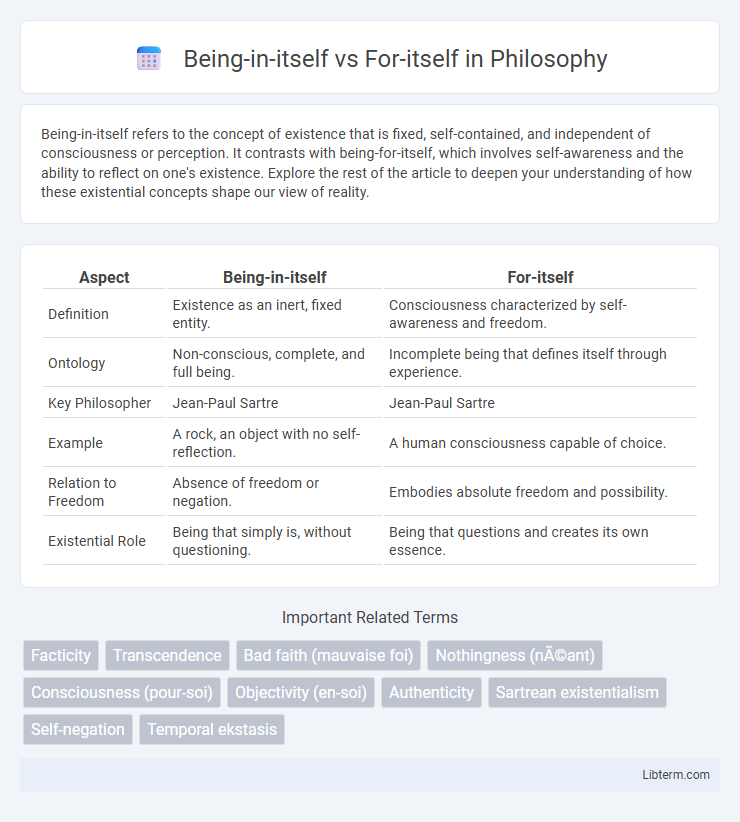Being-in-itself refers to the concept of existence that is fixed, self-contained, and independent of consciousness or perception. It contrasts with being-for-itself, which involves self-awareness and the ability to reflect on one's existence. Explore the rest of the article to deepen your understanding of how these existential concepts shape our view of reality.
Table of Comparison
| Aspect | Being-in-itself | For-itself |
|---|---|---|
| Definition | Existence as an inert, fixed entity. | Consciousness characterized by self-awareness and freedom. |
| Ontology | Non-conscious, complete, and full being. | Incomplete being that defines itself through experience. |
| Key Philosopher | Jean-Paul Sartre | Jean-Paul Sartre |
| Example | A rock, an object with no self-reflection. | A human consciousness capable of choice. |
| Relation to Freedom | Absence of freedom or negation. | Embodies absolute freedom and possibility. |
| Existential Role | Being that simply is, without questioning. | Being that questions and creates its own essence. |
Understanding Being-in-Itself: Definition and Origins
Being-in-itself refers to an existence that is complete, self-contained, and indifferent to consciousness, characterized by its fixed essence and lack of self-awareness. This concept originates from Jean-Paul Sartre's existential philosophy, where Being-in-itself contrasts with Being-for-itself, which denotes conscious beings capable of self-reflection and freedom. Understanding Being-in-itself involves recognizing its nature as an object that simply is, without the capacity for change or projection beyond its immediate state.
For-Itself Explained: Consciousness and Self-Reflection
For-itself refers to consciousness characterized by self-awareness and the ability to reflect on one's own existence, distinguishing it from being-in-itself, which lacks such awareness. It embodies the dynamic process of self-reflection, allowing individuals to define their identity through choices and actions rather than mere existence. This concept is central to existentialist philosophy, emphasizing freedom, subjectivity, and the continuous creation of the self.
Sartrean Existentialism: Key Concepts and Distinctions
Being-in-itself refers to the objective, non-conscious existence of things as they are, characterized by completeness and facticity without self-awareness. In contrast, Being-for-itself denotes human consciousness, defined by its ability to question, reflect, and transcend its given facticity through freedom and negation. Sartrean existentialism emphasizes this fundamental ontological distinction to illustrate how human existence is shaped by freedom, responsibility, and the ongoing project of self-creation.
Ontological Differences: Substance vs. Consciousness
Being-in-itself represents pure substance characterized by fixed, self-contained existence devoid of awareness or subjectivity, whereas Being-for-itself embodies consciousness marked by self-reflective awareness and intentionality. Ontologically, Being-in-itself is static and immutable, defined by objective presence, while Being-for-itself is dynamic and fluid, capable of negation, freedom, and the continuous construction of meaning. This fundamental distinction underpins existentialist philosophy's analysis of human existence as opposed to inert objects.
The Role of Negation in For-Itself
The concept of For-Itself in existential philosophy fundamentally involves negation as a defining feature, where consciousness continuously negates its current state to project possibilities beyond mere existence. Unlike Being-in-Itself, which is fixed and non-reflective, For-Itself utilizes negation to achieve self-awareness and freedom through the refusal to be solely what it is. This dynamic process of negation enables the For-Itself to transcend given realities, fostering authentic choice and existential self-definition.
Freedom and Responsibility in Human Existence
Being-in-itself represents the fixed, pre-existing nature of objects devoid of consciousness, while For-itself embodies human consciousness characterized by self-awareness and the capacity for freedom. Freedom in For-itself entails the ability to transcend deterministic facticity and make authentic choices, which simultaneously imposes the weight of responsibility for one's actions and their consequences. This dynamic underscores existentialist themes where human existence is defined through freedom and the ethical obligation to own one's existential project.
Bad Faith: Escaping Authentic For-Itself
Being-in-itself embodies a fixed, non-conscious existence defined by facts and essence, contrasting with For-itself, which possesses self-awareness and freedom to define its own essence. Bad Faith arises when the For-itself denies its inherent freedom and responsibility, adopting the deterministic nature of Being-in-itself to escape authentic selfhood. This evasion involves self-deception, where individuals suppress their capacity for authentic choice, thus rejecting their existential potential and living inauthentically.
Being-in-Itself and Objects: Static Existence
Being-in-itself refers to the mode of existence characterized by static, self-contained objects that simply are without consciousness or self-awareness. Objects in Being-in-itself possess an immutable essence, defined by their fixed properties and lack of internal contradiction or change driven by subjectivity. This ontological state contrasts sharply with the dynamic, reflective nature of for-itself, highlighting the unchanging, inert foundation of objective reality.
The Gaze of the Other: Impact on For-Itself
The Gaze of the Other profoundly shapes the For-Itself by revealing its existence as an object outside itself, introducing a fundamental tension between self-consciousness and objectification. This encounter disrupts the immediacy of Being-in-itself, as the For-Itself becomes aware of itself through the eyes of the Other, generating feelings of shame, vulnerability, and desire for recognition. Sartre's concept illustrates how the For-Itself's identity is continuously formed and destabilized through the dialectic of seeing and being seen.
Contemporary Relevance of Sartre’s Ontology
Sartre's distinction between Being-in-itself and For-itself remains influential in contemporary philosophy, particularly in existential and phenomenological discourses. Being-in-itself describes the fixed, self-contained existence of objects, while For-itself captures human consciousness characterized by freedom and self-reflection. This ontological framework continues to inform debates on identity, freedom, and authenticity in modern fields such as cognitive science, artificial intelligence, and existential psychotherapy.
Being-in-itself Infographic

 libterm.com
libterm.com